The End-of-line Packaging Industry Analysis in the United States is estimated to be valued at USD 7.3 billion in 2025 and is projected to reach USD 9.8 billion by 2035, registering a compound annual growth rate (CAGR) of 2.9% over the forecast period.
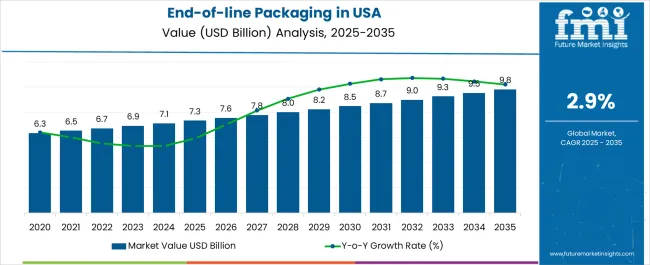
| Metric | Value |
|---|---|
| End-of-line Packaging Industry Analysis in the United States Estimated Value in (2025 E) | USD 7.3 billion |
| End-of-line Packaging Industry Analysis in the United States Forecast Value in (2035 F) | USD 9.8 billion |
| Forecast CAGR (2025 to 2035) | 2.9% |
The end-of-line packaging industry in the United States is experiencing significant expansion. Growth is being driven by increasing demand for efficient packaging solutions, rising production volumes across consumer goods and industrial sectors, and the adoption of automation to enhance operational efficiency.
Current market dynamics are characterized by investments in high-speed machinery, integration of intelligent control systems, and evolving regulatory requirements related to safety and environmental standards. The future outlook is shaped by technological advancements in robotics, sensor-based monitoring, and modular machine designs, which are expected to improve throughput, reduce labor dependency, and optimize overall equipment effectiveness.
Growth rationale is underpinned by the need for reliable, flexible, and scalable packaging solutions that can adapt to changing product specifications and consumer expectations Strategic deployment of automated systems, along with ongoing innovation in machine configurations and service offerings, is anticipated to sustain market expansion and strengthen competitive positioning within the United States.
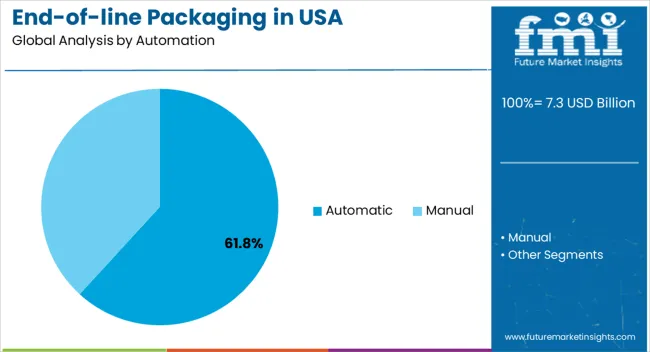
The automatic segment, holding 61.80% of the automation category, has maintained its leading position due to its ability to deliver high-speed, consistent, and error-free packaging operations. Adoption has been facilitated by the demand for labor reduction, enhanced process reliability, and improved production throughput.
Integration with digital monitoring and control systems has strengthened operational efficiency and minimized downtime. The segment’s growth is further supported by investment in retrofitting existing lines with automated solutions and expanding capabilities for diverse packaging formats.
Regulatory compliance and quality assurance protocols have reinforced end-user confidence Technological enhancements in sensing, actuation, and process integration are expected to sustain market share and support continued adoption of automatic solutions across multiple industrial applications.
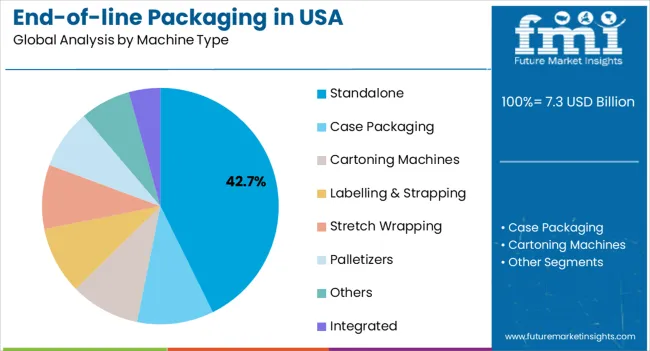
The standalone segment, representing 42.70% of the machine type category, has led the market owing to its versatility, ease of installation, and adaptability for specific production lines. Adoption has been driven by the need for targeted operational solutions that can function independently or be integrated into existing systems.
Standalone machines have provided flexibility for batch variation and process customization, supporting efficiency in medium-scale and specialty production lines. Maintenance simplicity, modular design, and lower capital expenditure requirements have further reinforced preference for standalone configurations.
Future growth is expected to be bolstered by advancements in machine interoperability, energy efficiency, and digital integration, ensuring that standalone systems remain a key choice for end-of-line packaging operations.
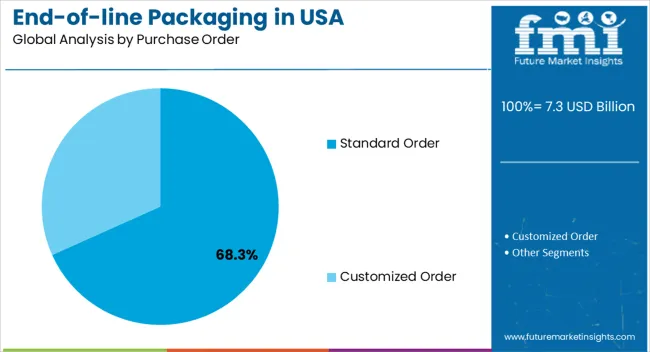
The standard order segment, accounting for 68.30% of the purchase order category, has emerged as the dominant procurement method due to its predictability, streamlined approval process, and alignment with existing production planning cycles. Adoption has been supported by established supplier relationships, standardized specifications, and efficiency in procurement logistics.
Consistency in delivery schedules and cost transparency has reinforced market confidence. Operational integration with supplier management systems has enhanced order tracking and fulfillment accuracy.
Continued focus on supply chain optimization, contractual reliability, and fulfillment efficiency is expected to maintain the segment’s market share and support broad adoption across the United States end-of-line packaging industry.
The United States, a developed nation for packaging, observes a statewide diversity in consumer behavioral patterns and packaging trends. United States-based packaging companies are primarily focused on improving the end-user experience.
Reducing production costs and limiting design configurations are secondary measures for United States-based packaging manufacturers seeking to extend their businesses domestically. They are constantly introducing automatic end-of-line packaging machines to attract customers.
Demand for packaging machines used for wrapping the goods and making them delivery-ready continues to gain traction in the United States. The food sector is poised to dominate the target business in terms of consumption of end-of-line packaging across the United States. This is due to the rising demand for packaged food products and the increasing adoption of automatic packaging solutions in food companies.
Demand for packaged food & beverage products is increasing rapidly with the advent of ready-to-eat products. To meet this demand, food manufacturing companies are increasingly employing end-of-line packaging machines, especially automatic ones, thereby boosting sales.
Manufacturers are increasingly opting for customized orders since these cater to the industry-specific needs and challenges faced by producers. As a result, the customized segment is estimated to dominate the United States industry, accounting for about 90% of value share in 2025.
The end-of-line packaging industry in the United States witnessed a CAGR of 0.9% during the historical period. It attained a valuation of USD 7.3 billion at the end of 2025. In the forecast period, sales of end-of-line packaging machines in the United States are projected to rise at a 3.1% CAGR.
| Historical CAGR (2020 to 2025) | 0.9% |
|---|---|
| Forecast CAGR (2025 to 2035) | 3.1% |
The past trends in the United States' end-of-line packaging industry reveal a story of change and progress. The United States end-of-line packaging industry has been undergoing change over time following technological evolution, changing demand, and industrial issues.
There has been a rapid shift from manual EOL practices toward more mechanized approaches. This is fueled by the high demand for efficiency and precision in operations and the need to satisfy customers in an ever-changing industry.
Today, more and more industries across the United States are incorporating automatic end-of-line packaging solutions to improve productivity & efficiency and reduce labor costs. This will play a key role in boosting the growth of the end-of-line packaging industry in the United States.
End users are investing in end-of-line packaging solutions that offer cost-effective operations, provide a positive return on investment (ROI), and reduce packaging waste. Similarly, automated end-of-line packaging machines are gaining immense traction across the United States.
Leading end-of-line packaging machine manufacturers are continuously introducing novel solutions to meet end-user demand. For instance, ROBOPAC USA introduced a complete range of end-of-line packaging solutions, including the new Robot Pick n Place palletizer, at Pack Expo 2020.
| Particular | Value CAGR |
|---|---|
| H1 | 2.2% (2025 to 2035) |
| H2 | 2.0% (2025 to 2035) |
| H1 | 4.1% (2025 to 2035) |
| H2 | 3.9% (2025 to 2035) |
EOL Machines Transforming Packaging Processes to Achieve Cost Savings
End-of-line machinery stands out as a highly efficient solution for United States-based manufacturers to mitigate superfluous labor and material expenditures. As a result, their demand is growing steadily in the nation.
The United States boasts one of the world’s top labor and machine operator wage structures, as underscored by a 2025 study conducted by the Reshoring Institute. According to this research, the United States ranks second globally, trailing Germany, with an average annual wage of around USD 32,000 annually.
End-of-line machines are experiencing growing demand from a variety of enterprises across the United States. This is because these machines reduce labor costs while improving overall productivity.
The end-of-line machinery helps significantly bring down packaging costs since it optimizes the amount of packaging materials required and reduces wastage. These automated systems not only conserve resources but also reduce the cost of materials, directly impacting the bottom line.
The reduction of material waste is particularly critical in an era where responsible resource management is becoming central to business strategies. Hence, the adoption of end-of-line machines to reduce labor costs & material wastage and enhance productivity will continue to boost sales.
Decentralized Procurement Challenges Impeding Packaging Efficiency
End-of-line packaging now uses a wide range of advanced technologies, such as automatic bagging systems and automated labeling techniques. Nonetheless, one of the issues that companies encounter is that they do not have centralized procurement.
The decentralization mainly arises as a result of diverse industries, which vary widely with respect to the needs for individually specialized machines at the end line of production lines. Although decentralization has a lot of advantages, there are certain issues involved with this approach.
A notable problem is the lack of uniformity, where different departments within organizations buy equipment from different manufacturers that are incompatible with each other. Decentralized purchase also tends to lead to low levels of bargaining strength because most independent departments lack the requisite bargaining strength. This can result in unfavorable pricing and higher costs.
The lack of centralized procurement can also hinder the possibility of economies of scale since distributed orders cannot guarantee low-cost savings. This can impact the target industry during the forecast period.
The corporation and concordance with a supplier, however, can lead to higher bargaining power, which translates to a more reasonable price tag as well as favorable contract conditions. This can improve overall value and translate into significant cost savings.
Trade Shows Providing Platforms for Innovation, Visibility, and Insight
Manufacturers of end-of-line packaging machinery take advantage of trade shows that constitute prominent stages. In these trade shows, they can demonstrate their products, advanced functions, and attributes of modern machines.
The United States serves as a vibrant hub for packaging machinery trade shows. These platforms allow manufacturers to demonstrate the latest end-of-line packaging machines and engage with a diverse audience. Events such as Pack Expo Las Vegas, Pack Expo International, and Luxe Pack occur annually or annually.
Taking part in such trade shows greatly enhances a manufacturer's profile in the field. It provides a chance to create brand awareness and promote trust.
The exposure gained in these events is beneficial in several ways. It is not only helpful for building a brand image but also gives the opportunity to network with other manufacturers, distributors, and prospective clients. Hence, a handful of crucial contestants, including Syntegon, BW Packaging, and Krones AG, take part in such trade shows.
The trade shows constitute critical sources for innovations and industry research that inform manufacturers about emergent trends, opponents’ tactics, and the changing needs of customers. Such inputs are important when improving old products or creating novel options that match changing customer requirements.
The below section highlights the projected CAGR of key segments, including automation and machine type:
| Automation | Value CAGR |
|---|---|
| Automatic | 3.7% |
| Manual | 1.7% |
As per the latest analysis, the automatic end-of-line packaging segment is expected to witness a steady CAGR of 3.6% during the forecast period. This is attributable to the rising demand for automated end-of-line packaging machines across diverse sectors due to adaptability and precision.
Adopting automatic end-of-line packaging machines is a new trend in the industry that reveals how flexible and accurate it has become to modern manufacturers. This movement portrays an even bigger development where more companies focus on simplifying their systems and attaining efficiency.
Automatic end-of-line machines come with artificial intelligence and robotic technologies that give them exceptional precision and uniformity not matched by manual processes. These automated systems are designed with adaptability that enables easy integration in different production lines whose products have varied specifications or packaging.
As industries look to improve their productivity and reduce labor costs, they must incorporate automatic packaging solutions in their facilities. This is expected to drive demand for automatic end-of-line packaging machines in the United States during the assessment period.
| End-use | Value CAGR |
|---|---|
| Standalone | 3.3% |
| Case Packaging | 2.3% |
Standalone machines are poised to dominate the United States end-of-line packaging industry, with a significant share of 78% in 2025. The target segment will also thrive at a CAGR of 3.3% throughout the forecast period.
Industries across the United States prefer standalone end-of-line packaging machines as they offer flexibility and scalability. The incorporation of standalone machines in modern production lines is an affordable way of solving specific packaging problems.
The system integrations provide holistic solutions. Growing demand for wraparound case packers, palletizers, and cartooning machines from several industries is expected to boost the standalone segment through 2035.
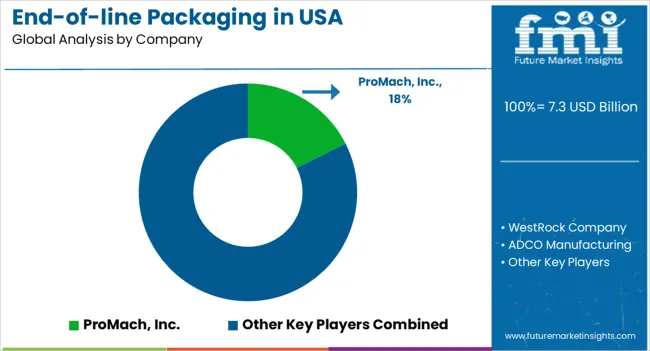
Key manufacturers of end-of-line packaging solutions are focusing on developing innovations and advancements to boost their sales and solidify their positions. They are also employing strategies such as acquisitions, mergers, partnerships, and facility expansions to strengthen their presence in the United States.
Recent Developments in the United States End-of-line Packaging Industry
| Attribute | Details |
|---|---|
| Estimated Value (2025) | USD 7.3 billion |
| Projected Value (2035) | USD 9.8 billion |
| Anticipated Growth Rate (2025 to 2035) | 2.9% CAGR |
| Historical Data | 2020 to 2025 |
| Forecast Period | 2025 to 2035 |
| Quantitative Units | Revenue in USD billion, Volume in Units, and CAGR from 2025 to 2035 |
| Report Coverage | Revenue Forecast, Volume Forecast, Company Ranking, Competitive Landscape, Growth Factors, Trends and Pricing Analysis |
| Segments Covered | Automation, Machine Type, Purchase Order, End-use, Sub-region |
| Key Companies Profiled | ProMach, Inc.; WestRock Company; ADCO Manufacturing; Duravant LLC; Combi Packaging Systems, LLC; BW Packaging; Syntegon Technology GmbH; Krones AG; I.M.A. Industria Macchine Automatiche S.P.A; Signode Industrial Group LLC; Ishida co. Ltd; Sidel Group |
The global end-of-line packaging industry analysis in the United States is estimated to be valued at USD 7.3 billion in 2025.
The market size for the end-of-line packaging industry analysis in the United States is projected to reach USD 9.8 billion by 2035.
The end-of-line packaging industry analysis in the United States is expected to grow at a 3.0% CAGR between 2025 and 2035.
The key product types in end-of-line packaging industry analysis in the United States are automatic and manual.
In terms of machine type, standalone segment to command 42.7% share in the end-of-line packaging industry analysis in the United States in 2025.






Full Research Suite comprises of:
Market outlook & trends analysis
Interviews & case studies
Strategic recommendations
Vendor profiles & capabilities analysis
5-year forecasts
8 regions and 60+ country-level data splits
Market segment data splits
12 months of continuous data updates
DELIVERED AS:
PDF EXCEL ONLINE
End-of-line Packaging Market Size and Share Forecast Outlook 2025 to 2035
Packaging Testing Services Market Size and Share Forecast Outlook 2025 to 2035
Packaging Tubes Market Size and Share Forecast Outlook 2025 to 2035
Packaging Jar Market Forecast and Outlook 2025 to 2035
Packaging Barrier Film Market Size and Share Forecast Outlook 2025 to 2035
Packaging Films Market Size and Share Forecast Outlook 2025 to 2035
Packaging Laminate Market Size and Share Forecast Outlook 2025 to 2035
Packaging Burst Strength Test Market Size and Share Forecast Outlook 2025 to 2035
Packaging Tapes Market Analysis - Size, Share, & Forecast Outlook 2025 to 2035
Packaging Materials Market Size and Share Forecast Outlook 2025 to 2035
Packaging Labels Market Size and Share Forecast Outlook 2025 to 2035
Packaging Equipment Market Size and Share Forecast Outlook 2025 to 2035
Packaging Resins Market Size and Share Forecast Outlook 2025 to 2035
Packaging Inspection Systems Market Size and Share Forecast Outlook 2025 to 2035
Packaging Design And Simulation Technology Market Size and Share Forecast Outlook 2025 to 2035
Packaging Suction Cups Market Size and Share Forecast Outlook 2025 to 2035
Packaging Straps and Buckles Market Size and Share Forecast Outlook 2025 to 2035
Packaging Coating Market Analysis - Size, Share, & Forecast Outlook 2025 to 2035
Packaging Testing Equipment Market Analysis & Growth 2025 to 2035
Packaging Bins Market Trends - Growth & Demand 2025 to 2035

Thank you!
You will receive an email from our Business Development Manager. Please be sure to check your SPAM/JUNK folder too.
Chat With
MaRIA